Today I collaborated on a poem with my mom. How is that possible, you ask, since she died several years ago? No, I didn’t hold a seance. As I was putting together the content for this posting, I came across a manuscript of hers she’d written in 1998, a poem she’d intended to submit to Cricket. It was in a rough, unfinished state, and somehow I just felt like working on it. I used most of her poem, revising many of the lines, and built a new poem around it. It tripled in length, but I maintained the spirit of what she was doing — now it sounds like both of us. I’m sure she’d approve; we did this sort of thing all the time while she was alive, so why stop now, huh? I believe I will try submitting it to Cricket. I’ve never had any luck selling a poem to them, but if they’d accept this one, it would mean Mom would have a by-line in Cricket at last.
Since I’m submitting it, I can’t publish it here — but I will if they reject it. (Don’t be disappointed — something of Mom’s is coming up here as soon as I’m done with my rambling report!)
As far as I can tell, the RSS feeds I tried to set up are working. One more time, to be sure you know what I’m talking about: when you first arrive for the day at this page, there’s a calendar and a lot of stuff in blue letters over at the right, right? Scroll down, and under all those Tag words in various sizes, there are two big buttons that say “RSS-Posts” and “RSS-Comments.” I tried clicking on the one for posts, and it took me right to a way to set up an RSS feed for this blog. (I didn’t go to the final step, because I don’t want notification when I post a new post: I’d rather not know. . . .) So I believe anyone who wants to be automatically notified when a new post is up can be.
Next: Nicholas Ozment, who appeared in an interview here a few weeks ago, has expanded on part of what he said about flash fiction, and you can read more from him on the topic at http://www.everydayfiction.com/flashfictionblog/killing-darlings.
Okay, here’s a true story: The following caption appeared under a photo in my hometown’s newspaper recently:
“Part of a tree was broken off on the courthouse lawn by the Abe Lincoln statue.”
[Shudder!] I knew there was something sinister about that statue! Apparently it comes alive in the dead of night and breaks municipal trees. There’s no horror like small-town horror.
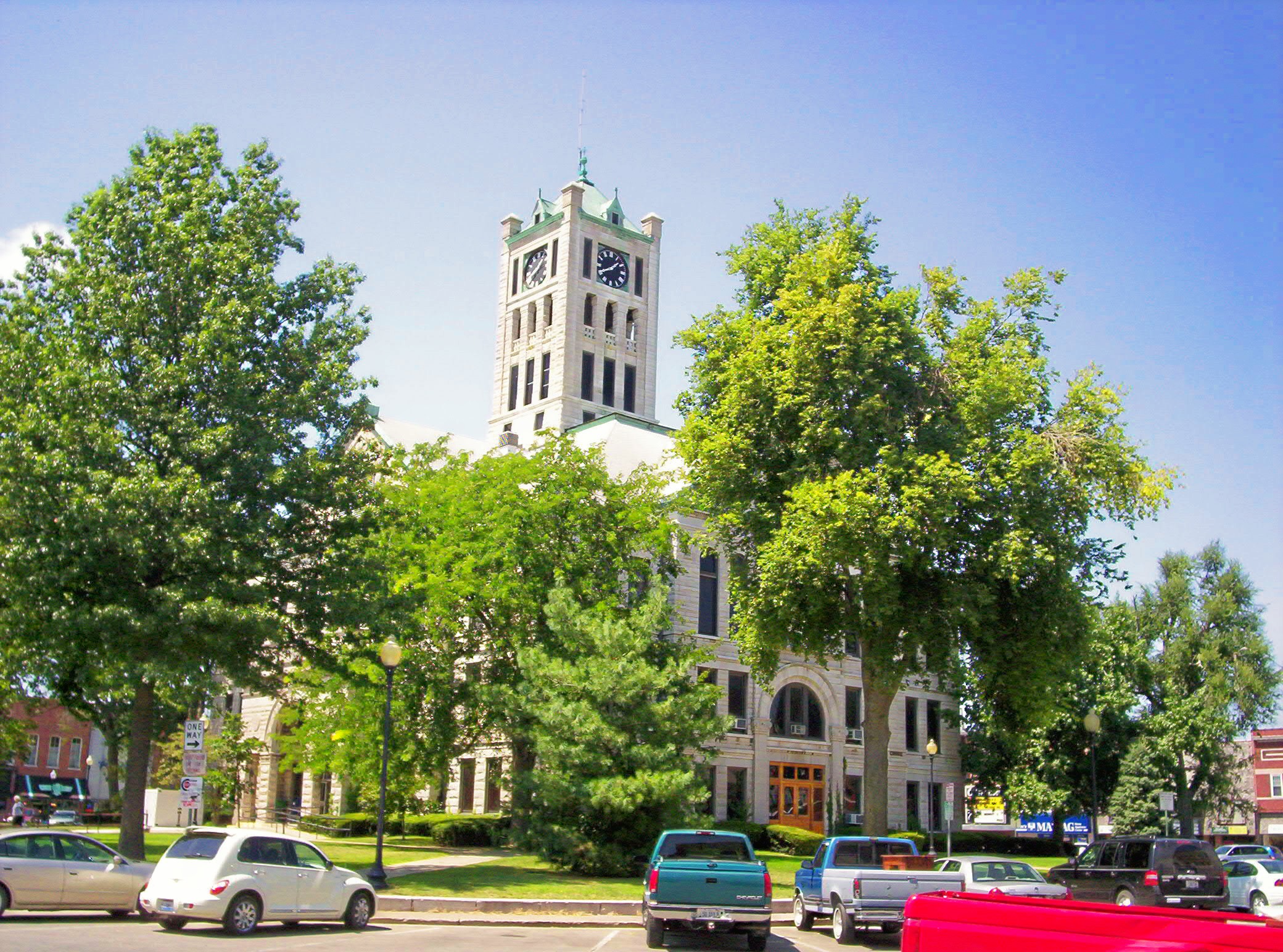
The Christian County Courthouse in Taylorville, Illinois
There it is, the courthouse lawn, where the sinister statue lurks. (Ooh, didn’t Vachel Lindsay have a poem called “Abraham Lincoln Walks at Midnight”? [!!!] Strangely prophetic!) This was taken from the opposite corner to where the statue is. What you don’t see is usually scarier (in movies) than what you do see. . . .
Sure, we still have plenty of trees, but I’m certain you’d agree this can’t go on. I hope the Taylorville police are being issued bronze-piercing bullets.
All right, getting serious now (grroink!):
I want to be absolutely sure no one missed the last few comments on the post before this one. Please go back there and read them. You all who read the blog — thank you so much for being here. Just reading it is fine — you’re very welcome to do that. But when you take the time to comment, everyone benefits. What we have here is a fully-interactive salon for those who love stories, for those who love friends, and for those who love life. And like a college dormitory or a World Fantasy Convention, it goes on 24/7. We live in different time zones, different hemispheres, so you never know when something will pop up, when someone will have pulled a chair up to the fire and be ready for some merry company.
Anyway, in those last couple comments, Shieldmaiden and Marquee Movies were talking about the end of The Hobbit, how it’s one of the best endings in any book out there. And they were discussing those wonderful places we gather, the places we spend time doing things we love, perhaps with the people we love. (I won’t repeat them here, but I mean it — go back and read those comments!)
What places in stories would you add to the list? Places of comfort and peace, good cheer, replenishment, and comradery. . . . I think that’s where we want to go in our communal reminiscing this week. Tell us the places you love in books, stories, and/or movies where the characters gather — those best, unforgettable, infinitely inviting places that you wish you could go and live in.
And — you’re also encouraged to tell us about actual places that you love to spend time — either now, or at some previous stage of your life.
Who can forget Doc Graham in Field of Dreams, sitting Ray Kinsella down in his office on that magical night and saying, “This is my special place. When you find your own special place, the wind never blows so cold again”? And in the same film, Ray answering Shoeless Joe’s question “Is this Heaven?” with “No; it’s Iowa.” And then later glancing from the miraculous baseball field he’s carved out of a cornfield — gazing up to where his wife and daughter are sitting on the porch swing, and realizing that it really is a part of Heaven, after all — the place where dreams come true.
By the way, I’ve actually been to the Field of Dreams, the one where the movie was filmed. The baseball field, the farmhouse, and the cornfield are still maintained, just as they appear in the movie, in Dyersville, Iowa. You can still see, carved into one seat on the bleachers, “Ray Loves Annie” inside a heart. Marquee Movies and I went there together and spent an afternoon I will never forget, playing catch with a baseball, lounging on the bleachers, and venturing into the cornfield, where you can almost hear the whispers of Shoeless Joe and his teammates. Also, I ran the bases. And Marquee Movies walloped a ball way out into center field. You can go there, too, if you’re ever in Iowa. I totally recommend it.
The serendipitousness of this topic is that it segues perfectly into what I was already planning for this post’s main event. I’m going to take you back to 1991, to a pair of essays written by my mom and dad about their special places.
Here we go, then. Ladies first: these are the words of my mother, Mary Anne Durbin.
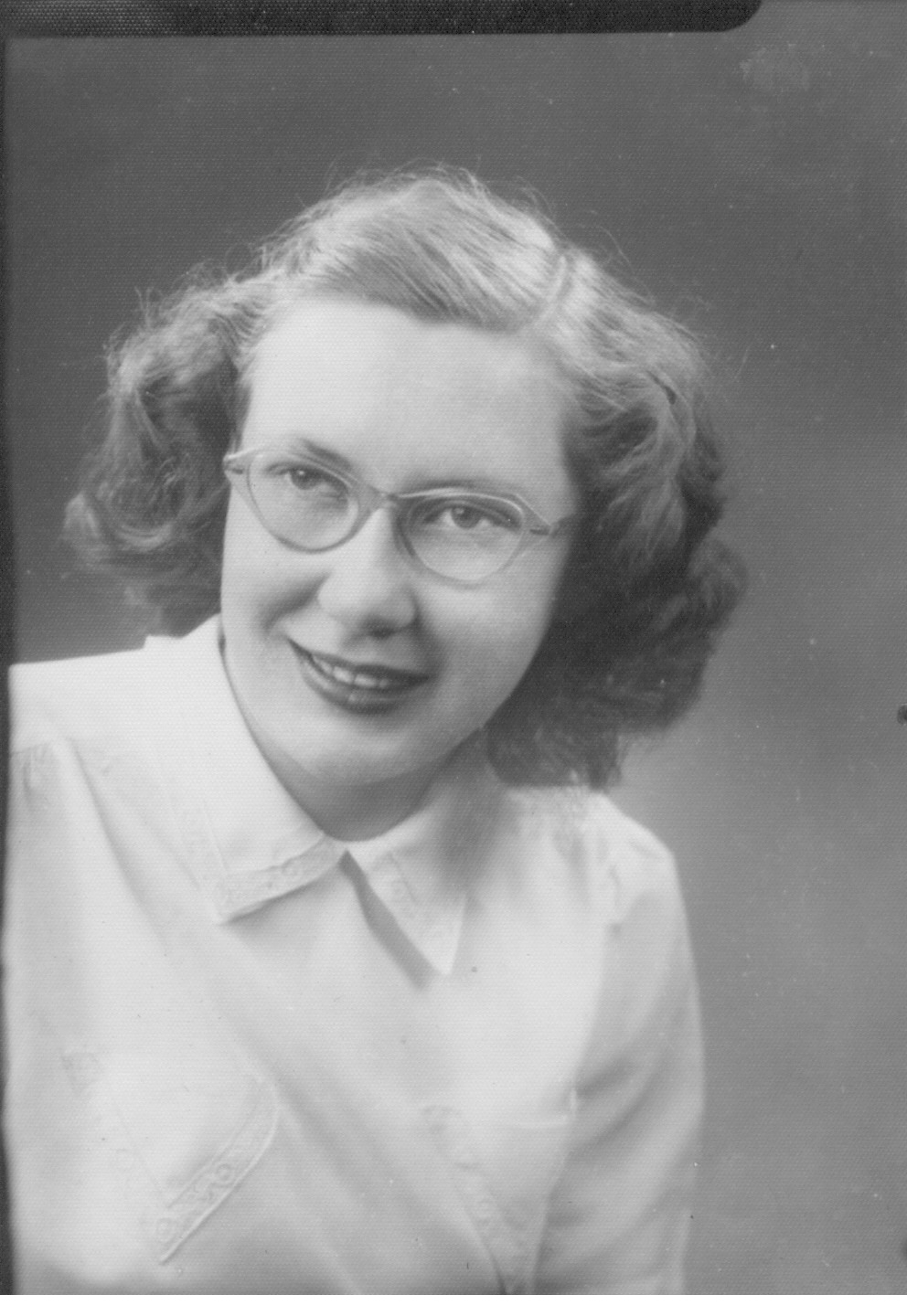
Mary Anne Durbin as a senior in high school
When Joe and I first married, our kitchen table was small because the kitchen was small.
After our son Fred was born, we added first a bassinet, then a low “play table” and finally a high-chair off to the side, so our son could learn what to do about food and books.
Then we doubled the size of the kitchen, so that meant a larger table.
We went shopping, which consisted of attending auctions until we found a wooden table to our liking. Somehow chrome and Formica can’t make a proper kitchen table. This one was perfect — a long harvester’s table that can sit four on each side and two on each end.
As I sit at the kitchen table, the stove and refrigerator are behind me. When a meal is ready, I tell Joe and Fred (if he’s home), and they come with books in hand to enjoy a good repast.
Something from the garden is at almost every meal throughout the year. In season, and especially in the springtime, flowers from the yard also have a place on the table.
I fill the plates from the stove, and pass them to Joe and Fred, along with the proper utensils for the meal.
In the center of the table is my German grandmother’s “spoon jar,” in case they need a teaspoon.
I have never mastered the art of reading and eating at the same time, but it is fun to hear the comments and views of what is current with Joe and Fred, or to hear an occasional passage read aloud.
When a meal is not in progress, the table is mine!
Upon arising, the little Bible and daily devotions at the table set a proper direction for the day.
At my left elbow is the “slush pile” of incoming mail. We subscribe to a few good magazines and contribute to a few good charities, so there is plenty of mail each day.
The Smithsonian goes directly into the bathroom for serious reading; others go onto the slush pile to be read as time permits. When I have finished with something, I pass it across the table where Joe has a similar pile at his right elbow.
Also on my slush pile are blank backs of junk mail for creative composition. The telephone is at my right elbow. In front of it are letters to answer and small pieces of blank-backed paper for taking notes.
A chair to my right holds my purse — the filing case for letters to mail, coupons to use, papers to take to town, and bills to pay.
Beyond the phone, on the far corner of the table, are the phonebook, writing tablets, papers to file in other locations throughout the house, and papers to recycle.
My dining room table is reserved for more exacting work — treasurer’s reports, income tax preparation, and newsletter mailings.
A final professional polish is put on all our creative work at the word processor on my desk in my office.
But it is the kitchen table, with all its mess of creativity, that is my favorite spot. Life is a prayer to be lived, and at my table are nourishment for the body, mind, and soul. Here is the stuff of true freedom — to worship God, to serve a husband, to nurture a child, to welcome friends, and to truly fulfill oneself.
There you have it. All my deepest conversations with Mom took place, usually late at night, at that table. That’s where we’d sit when relatives came to visit: Dad’s side of the family are living-room sitters; Mom’s side are kitchen-table sitters. And I always had better luck writing at the kitchen table than at any desk I ever set up. There’s something homey and approachable and forgiving about a kitchen table. You’re under no pressure there.
Moving along, then, here’s Dad. The following essay is by Joseph Durbin, summer 1991:
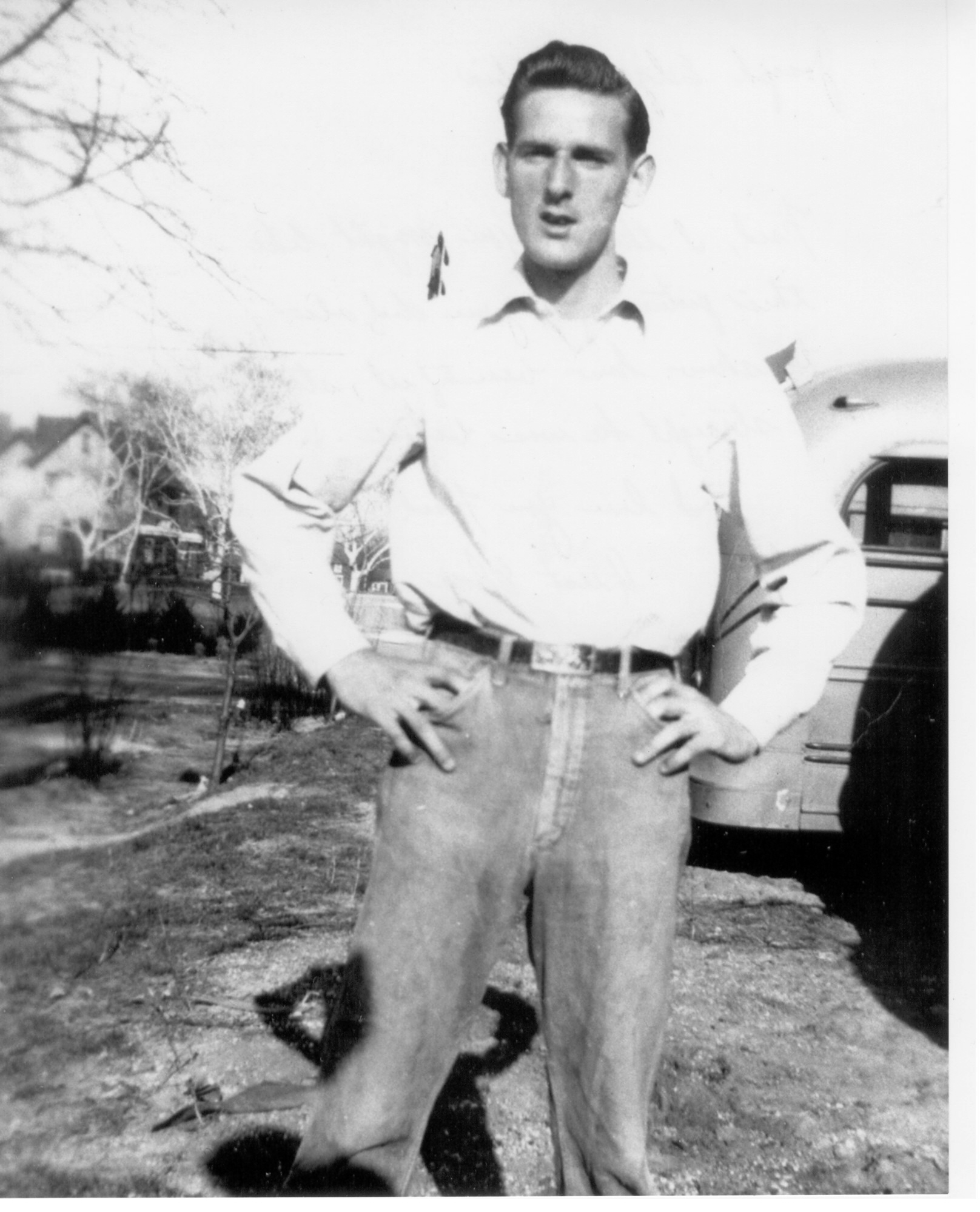
Joseph Durbin at about age 20
My little pond, located on the southeast corner of our 10-acre plot, is the place dearest to my heart at my home.
My wife, Mary Anne, and I had the pond dug when our son Fred was 11 years old. That was in June 1977. He and his friends spent many happy hours there growing from children into young men and women.
In addition to being the site of much swimming, fishing, boating, and camping, it also was the premier locale for my son’s many home movies, and later, video films.
He had a passion for writing his own scripts and then enlisting his friends to act them out for the camera. Many times I was drafted to perform at the video camera when the script called for my son to appear in the production.
I was part of the gang, accepted by the group. I can remember the day when the boys had me film them as they rode their bicycles, one by one, down the hill and into the pond, reciting poetry all the way. It was hilarious! The short, bumpy ride, the brief airborne phase, and later, the huge splash!
The pond is an enchanted place because in most people’s eyes it would appear to be no more than a mere mud hole. That is because they see only with their visual senses. If they could see with their hearts, they would view an ever-changing panorama of life. The pond itself changes in size and content of life depending on rainfall or the lack thereof.
In the drought of 1988, Fred and I grasped the opportunity of low water to build a concrete retaining wall across the base of the earthen dam. Fred had never worked with concrete, but as a child had seen me pour sidewalks around our home. After I explained the process to him of the proper proportion of sand, gravel, cement, and water, he was great.
I was able to work on building the forms and putting them into place. And he kept the concrete coming to me. It seemed as if we could read each other’s thoughts.
Later Fred journeyed to Japan to teach English as a second language. In addition to his classes of school children, he also had a group of about a dozen housewives as students. Fred must have told them many wondrous tales about the “enchanted pond,” because one of his students, Michiko, and her two small sons, came to the United States in August 1990 for a visit with us. They just had to see all the places that Furedo-san had talked about in his classes. Needless to say, they also became enchanted with our pond.
As to the future of the pond? If I were younger, I would build a “yellow brick road” around the perimeter. At various places along the path, I would have figures of fairy-tale characters hidden in the grass or beneath the trees. I would have a footbridge across the shallow end, and also several little waterfalls to slow the water down as it entered the pond from the fields.
On the pond itself, I would float replicas of Viking dragon ships for the boys to ride on, and for the girls, perhaps swan boats.
But, alas, I’m getting too old, and the task is beyond me. But I can dream, and that is what the “enchanted pond” is all about.
And that’s Dad. You can see why I love that little piece of land so much. I have the best memories of summer twilights, the fireflies winking all around, sometimes a startled deer fleeing before us from the water’s edge as we approached. Dad would sit beside the water, smoking a cigarette, basking in the serenity. The purple woods marched away to the south and east. I would sit and read Stephen R. Donaldson, or Stephen King, or Clark Ashton Smith, or Lord Dunsany (those are some specific “pond books” I remember). Down there, I’ve encountered a wild fox red as fire. And once, I was stalked by a bobcat while camping with the reader of this blog whose icon is a brown snowflake! Wonderful place. Wonderful time.
Wonderful parents!
So, tell us your stories! Places? From your own experience, from stories . . . places in the heart.
Oh, yes — I stole that title from a beautiful movie starring Sally Field, Danny Glover, and John Malkovich. You should definitely see it!
Okay, we’ll close with a few pictures from the actual movie-location Field of Dreams in Dyersville, Iowa.

Fred on the bleachers at the Field of Dreams
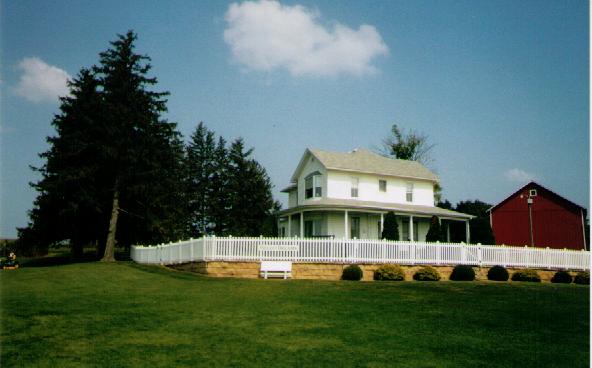
The place where dreams come true.
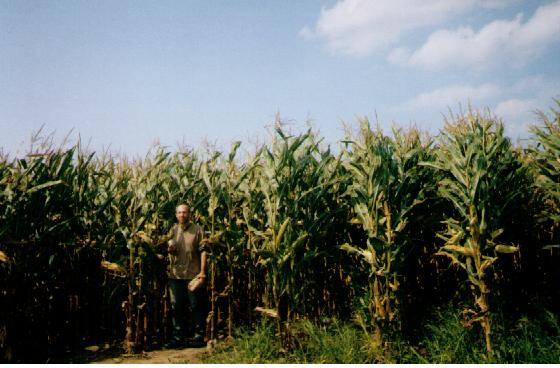
"If you build it, he will come." (I'm in this picture -- see me?)
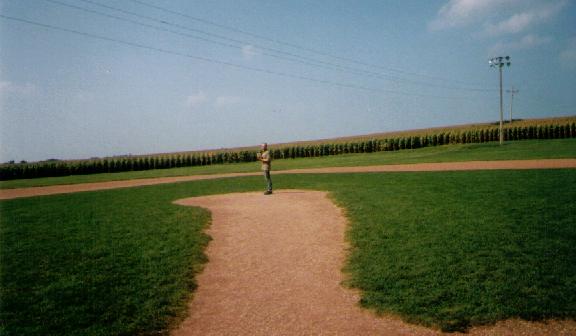
Fred on the pitcher's mound at the Field of Dreams (I'm in this one, too! See me?)
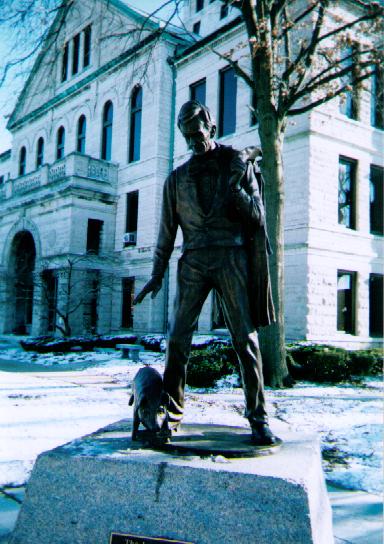
GYAAAAAAAAAAAAAAAAAHHHHHHHH!!!!!!